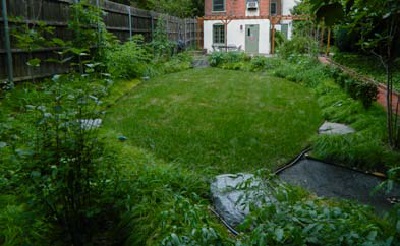
Tucked behind Penn’s Greenfield Intercultural Center (GIC) at 37th and Chestnut is a small, narrow lot. For many years, it was just that—a backyard space that GIC students and staff used occasionally for barbecues and receptions. Aside from a couple of new flowerpots, it was mostly unkempt; weeds speckled the yellowed grass and tangled grape vines overwhelmed the small stone patio. Yet, there has always been something special lying beneath the grass…something in the earth far older and more complex than the University itself. The GIC and the entire University of Pennsylvania campus sit on the ancestral homelands of the Lenape, a tribe also known as the Delaware Indians that made their home in the Delaware River watershed. The land has been the physical and spiritual home of the Lenape for centuries, dating back to the first ancestors.
One of GIC Director Valerie DeCruz’s tasks is to promote the Center’s mission: to foster intercultural understanding and awareness among Penn students. As home to the student group Natives at Penn, it came naturally to create a space at the GIC to acknowledge and honor the Lenape people. This past spring, the GIC collaborated with members of the local Lenape community and Penn landscape architects to transform the once-humble backyard into a Lenape garden. It was finished in May, just in time for a special blessing ceremony during the 2013 Commencement to honor graduating GIC students. Ann Dapice (NU’74, GR’80), Chair of Penn Native Alumni and a Lenape elder who holds a Ph.D. in Nursing, led the garden blessing with her wisdom and prayer.
Today, when one visits the same backyard, one will see the embodiment of tradition. The garden is not only replete with plants native to this land, but its design also tells stories of the Lenape people. The garden is shaped like a turtle, with five boulders to mark its head and feet and a grass oval to represent its shell. In Lenape creation stories, the turtle carried the Lenape people on its back to their homeland. Honoring these creation stories with a garden represents core Lenape story motifs: the body’s inherent connection to the sacred earth.
What is truly revolutionary about the garden, however, is that the traditional plants grown here can be prepared for use today just as they were centuries ago. The trees and shrubs planted around the turtle provide time-honored foods, and fibers to make straight and strong arrow shafts. The herb garden, a plot near the turtle’s head, is a Lenape medicine cabinet. Herbs such as black cohosh (sekkohosh) and elderberry (puhwesenakwim) can be processed using traditional Lenape techniques. The various leaves and stems are used as medicine for everything from kidney disorders to depression. Native American health focuses on the balance of a holistic physical and spiritual well-being. Disease is an imbalance, cured by the powers of nature and self-healing. In the scope of indigenous epistemologies, the garden is a positive addition to the Penn community that will help embrace and balance the health of students, both native and non-native, while acknowledging the surrounding and underlying Lenape homeland.
The garden is also an educational supplement to the University, as it teaches Lenape tradition through its existence on campus. Tina Fragoso, Penn Admissions Officer and Nanitcoke Lenni-Lenape, explains that, “The garden is a happy reminder that this is Lenape land, a place where my ancestors have lived and prayed for generations, [but] people, from many nations, can share this special place together in social and sacred ways.” Fragoso was a pivotal figure in creating the garden, as she recruited the help of her local Lenape community to provide a wealth of Lenape knowledge about native plants. Beside each of the 16 plants, one will find a label with the traditional Lenape name and its English translation. Shelley DePaul, Assistant Chief of the Pennsylvania Lenape and tribal linguist, provided the native translations and shared her knowledge of the traditional medicinal uses for each plant.
The future plans for the garden include a possible partnership with the Morris Arboretum’s Netter Center to create a guided educational tour for students to learn about the Lenape and traditional plant medicine. The garden represents how new generations of Native peoples, through creativity and collaboration, keep traditional knowledge alive. Tradition must grow and change in order to survive, and through the educational and spiritual purpose of the new Lenape garden, the GIC is carrying on tradition.
| Lenape Name | Common Name | |
|---|---|---|
| TREES | sipuwasimenshi | serviceberry |
| shimenshi | hickory | |
| tsugwalâga tsegwa (Cherokee) | magnolia bush | |
| ketamunshi | hazelnut | |
| SHRUBS | Whippinong | arrowwood viburnum |
| wepin | blueberry | |
| sakwenakanimunshi | dwarf viburnum | |
| sipuwasi | beach plum | |
| kaxhaxgik | bayberry | |
| nátû‛tlĭ (Cherokee) | spicebush | |
| puhwesenakwim | elderberry | |
| MEDICINAL HERBS | sekkohosh | black conosh |
| BeeBalm, Oswego tea (English) | bergamot | |
| Saloli gatoga(Cherokee) | yarrow | |
| uganástĭ útana (Cherokee) | Solomon’s Seal | |
| Skwálǐu´tana (Cherokee) | wild ginger |
